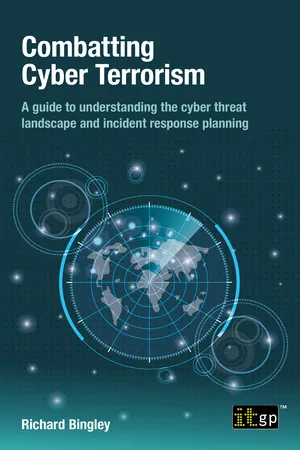
Combatting Cyber Terrorism
A guide to understanding the cyber threat landscape and incident response planning
- 315 pages
- English
- ePUB (mobile friendly)
- Available on iOS & Android
Combatting Cyber Terrorism
A guide to understanding the cyber threat landscape and incident response planning
About this book
In his second book with IT Governance Publishing, Richard Bingley's Combatting Cyber Terrorism – A guide to understanding the cyber threat landscape and incident response planning analyses the evolution of cyber terrorism and what organisations can do to mitigate this threat.
This book discusses:
- Definitions of cyber terrorism;
- Ideologies and idealisations that can lead to cyber terrorism;
- How threat actors use computer systems to diversify, complicate and increase terrorist attack impacts;
- The role of Big Tech and social media organisations such as X (formerly Twitter) and Instagram within the cyber threat landscape; and
- How organisations can prepare for acts of cyber terrorism via security planning and incident response strategies such as ISO 31000, ISO 27001 and the NIST Cybersecurity Framework.
Increasingly, cyber security practitioners are confronted with a stark phrase: cyber terrorism. For many, it conveys fear and hopelessness. What is this thing called 'cyber terrorism' and what can we begin to do about it?
Malicious-minded ICT users, programmers and even programs (including much AI-powered software) have all been instrumental in recruiting, inspiring, training, executing and amplifying acts of terrorism. This has resulted in the loss of life and/or life-changing physical injuries that could never have occurred without support and facilitation from the cyber sphere. These types of attacks can be encapsulated by the phrase 'cyber terrorism'.
This book recounts case studies to show the types of threats we face and provides a comprehensive coverage of risk management tactics and strategies to protect yourself against such nefarious threat actors. These include key mitigation and controls for information security or security and HR-related professionals.
Frequently asked questions
- Essential is ideal for learners and professionals who enjoy exploring a wide range of subjects. Access the Essential Library with 800,000+ trusted titles and best-sellers across business, personal growth, and the humanities. Includes unlimited reading time and Standard Read Aloud voice.
- Complete: Perfect for advanced learners and researchers needing full, unrestricted access. Unlock 1.4M+ books across hundreds of subjects, including academic and specialized titles. The Complete Plan also includes advanced features like Premium Read Aloud and Research Assistant.
Please note we cannot support devices running on iOS 13 and Android 7 or earlier. Learn more about using the app.
Information
Table of contents
- Cover
- Title
- Copyright
- About the Author
- Contents
- Chapter 1: Introduction
- Chapter 2: Cyber terrorism – ideologies and idealisations
- Chapter 3: The role of social media companies
- Chapter 4: Business, infrastructure and advanced technologies
- Chapter 5: Security planning and incident response
- Concluding remarks
- Appendix A: Key organisations and digital platforms
- Appendix B: Terrorism groups
- Appendix C: Glossary
- Appendix D: Bibliography
- Appendix E: Cyber crime types and related cyber-dependent/cyber-enabled offences
- Further reading